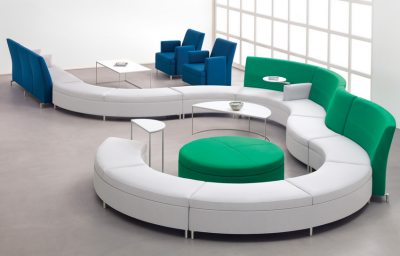How to Select Commercial Grade Fabric that Provides Lasting Value
![]()
Return to Indoff – Silicon Valley
If you want your office’s seating to keep its’ good looks for many years, key factors in the fabric are durability, light-fastness, and cleanability. Durability means how much normal wear a fabric can resist before it begins to show wear. Light-fastness is the ability of the fabric to endure light without fading. And Cleanability is associated with water or solvent cleaners or bleach in healthcare facilities.
How to get durability information.
Standardized “Rub” Tests on fabric give you a number that shows the fabric’s resistance to wear. This is sometime know as “Performance”. The higher the number, the longer the fabric will last. For example, on a Textiles web site, when looking a fabric’s pattern, you can also click on “specifications” and see the double rub (D.R.) rub count for each product.
In everyday terms, this is essentially the wear that happens every time you sit on the furniture.
High rub count fabric is used in high traffic areas like waiting room in hospitals and dentists offices. Fabric counts in these areas can be as high as 250,000 double rubs. Police departments with duty belts of nylon or leather and metal equipment might have double rub counts of 500,000 to 1,000,000.
While residential furniture might have 15,000 double rubs, you should select 25,000 or more for frequently used pieces in your home especially around kid and pets.
And most experts agree that HD or Heavy Duty fabric, with a minimum of 30,000 to 40,000 or more double rub counts, are important for commercial furniture.
Table of Suggested Rub Counts for Commercial and Residential Applications
Materials/Locations
Suggested Double Rub Count*
Very Heavy Duty Commercial, High Traffic Areas
100,000+
Heavy Duty Commercial, High Traffic Home Areas (Family Room/Den)
30,000+
Medium Duty, Home Living Rooms, moderate home traffic areas
15,000 to 30,000
Light Duty, occasional use areas, not upholstery
9,000 to 15,000
Delicate Duty, toss cushions, draperies
under 9,000
Avoid fabric fading with higher lightfastness numbers.
Fabric is often graded on how permanent a color is on the fabric after exposure to light. Both natural and synthetic fabrics are subject to fading or discoloration under sunlight and fluorescent light.
Grade 5 means there is no fading. Grade 4 means there is slight fading. Upholstery fabrics should have a minimum rating of 4 regardless of end use. Sometimes you will see lightfastness in terms like 40+ hours.
Match the fabric’s cleanability to your environment.
Fabrics have recommended cleaning methods. Some allow water based cleaning agents (Code W). Some with Code “S” should be cleaned only with mild water-free cleaning solvent or dry cleaning products.
Code W-S can be cleaned with either water or solvent based products.
Code X should be vacuumed or gently brushed only.
If you are in a healthcare environment, look for “high performance” fabrics that can be bleach cleaned or coated with Teflon for thorough cleaning.
Seating pricing varies significantly with the price of the fabric. Better, more durable fabrics are typically more expensive but on flip side, these fabrics retain their good looks for years. Indoff – Silicon Valley Branch can provide advice on fabrics to use for your unique circumstances that both look great and will serve the needs of visitors and staff for years.
To learn more about fabric testing standards <click here>
* Using Wyzenbeek Method <click here for more info>



